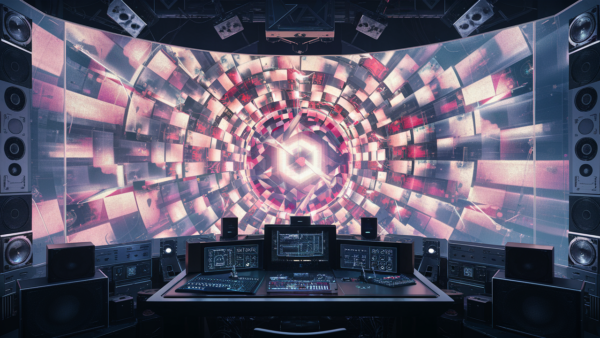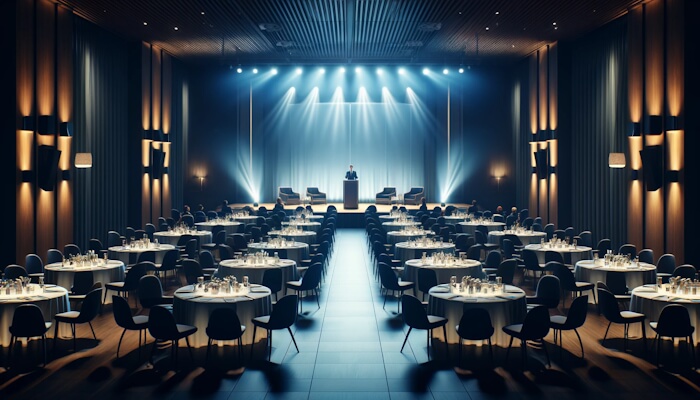Lighting isn’t just about brightening up a space. It’s a powerful tool that can transform the atmosphere of your events, emphasize key features, direct the flow of attendees, and capture your audience’s attention.
In this guide, we’ll dive into the art and science of event lighting, covering everything from selecting the perfect colors to strategic placement.
Whether you’re an experienced AV tech or just starting out, these event lighting best practices will help you master the art of lighting to create unforgettable event experiences.
Get a Clear Picture of the Venue
Before you dive into crafting your lighting masterpiece, you need to lay the groundwork by understanding the venue inside out.
Get familiar with its layout, architectural quirks, and standout features. Are there any nooks and crannies that could use a bit of extra light? Any specific structures or areas your client wants to highlight? These will help guide the blueprint for your lighting setup.
You’ll also need to identify where power outlets are located and how they align with your lighting plans. That will help you avoid any last-minute scrambles and keep your lighting rig running smoothly throughout the event.
And don’t think because you’re outside, you can rely solely on sunlight. Outdoor events present their own set of challenges, from unpredictable weather conditions to varying levels of natural light.
Decide What Light Fixtures Work Best for Your Event
The type of light fixture you use is extremely important. Each one has its own application and benefits. Some of the most common options include the following:
- Spotlights: Ideal for highlighting focal points such as keynote speakers, performers, or branded signage. They provide focused beams that draw attention to specific areas of the event space.
- Wash Lights: Perfect for creating a wash of color across large areas or stages. These versatile fixtures can set the mood and ambiance of the entire venue, providing a vibrant backdrop for the event.
- Gobos: You can add a touch of customization with Gobo projectors, which allow you to project patterns, logos, or textures onto walls, floors, or ceilings. Gobos can be used to reinforce branding, create thematic elements, or add visual interest to bland, blank surfaces.
- LED Panels: Versatile and energy-efficient, LED panels offer dynamic lighting effects and can be programmed to change colors, patterns, and intensity. They’re great for creating eye-catching displays, backdrop accents, or even interactive lighting experiences.
Moving Heads: If you need dynamic movement, versatility, and precision control, then opt for moving head fixtures These fixtures are perfect for adding excitement and energy to performances, dance floors, or stage productions.
Use Lighting Techniques to Your Advantage
You can use lightning techniques to transform the atmosphere and ambiance of your event – and the best part is that these techniques are relatively inexpensive.
Popular lighting techniques include:
- Uplighting: Strategically placing lights at the base of walls or architectural features adds depth and drama to the venue. Uplighting creates a sense of verticality that enhances textures and creates a dynamic backdrop for the event.
- Downlighting: Casting light from above creates a more intimate atmosphere and draws attention to specific areas or activities. Downlighting is particularly effective for highlighting focal points such as centerpieces, stages, or speaker podiums.
- Layering: Combine different lighting techniques and fixtures to create depth and dimension in the venue. By layering light sources, you can control the mood and atmosphere, guide attendees’ focus, and create a multi-dimensional experience.
- Dynamic Effects: Incorporate dynamic lighting effects such as color changes, patterns, or movement to engage the senses and elevate the overall ambiance. This could be pulsating rhythms on the dance floor or subtle transitions during presentations.
Once you understand the fundamentals of these techniques, you’ll be able to make a great (dare I say, enlightened) first impression on the attendees.
Leverage Color Theory and Psychology
While colors are pretty, they’re also powerful tools for shaping emotions and setting the mood. You can leverage the principles of color theory and psychology to use lightning in effective ways.
Different colors evoke different emotional responses. For example, cool tones like blue and green are often associated with calmness and tranquility.
Picture a corporate gala with a soft blue hue that bathes the venue, creating an atmosphere of sophistication and relaxation. Attendees feel at ease and it makes it easier for them to make meaningful connections and engage with the event content.
On the other hand, warm tones like red and orange give off energy and excitement.
Think about a vibrant product launch with dynamic red lighting that ignites the room, creating a sense of urgency and anticipation. Attendees are energized, and primed to explore and interact with the showcased products.
So don’t overlook color when designing your lighting setup for events. It’s another simple way to make a large impact.

Extra Tips and Tricks for Event Lighting
While we’ve covered the essential best practices, there are more tricks up our sleeves to take your lighting game to the next level!
- Understand your client’s desires and vision for the event to tailor the lighting design to their specific tastes.
- Invest in lighting control systems that offer flexibility, precision, and user-friendliness.
- Lightning should seamlessly integrate with the rest of your AV setup. For example, synchronized lighting cues, effects, and transitions can make presentations more immersive and engaging.
- Prioritize thorough testing and rehearsals before the event to iron out any technical glitches and ensure flawless execution.
- Opt for energy-efficient LED fixtures, incorporate motion sensors, and use programmable controls to maximize energy efficiency without compromising on quality.
With all of these tips combined, you’re ready to use event lighting to its full potential.
Final Thoughts
Remember, lighting is all about crafting unforgettable atmospheres, guiding emotions, and leaving a lasting impression on attendees long after the lights dim.
From color theory to employing advanced lighting techniques, you can use lighting in creative ways to bring your client’s vision to life.
As you master the art of event lighting, you want your presentations to shine just as bright. And that’s where Preseria’s innovative presentation management software comes into play.
You can effortlessly schedule, manage, and organize speakers and their content – no matter the number or the size of the event. Ensure everyone is on the same page with easily distributable guidelines, collect the materials well before the presentation, and keep everything moving smoothly even as hundreds of speakers take the stage.
Ready to experience seamless presentation management? Contact us today to see Preseria in action!
